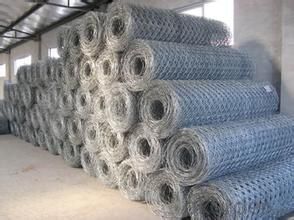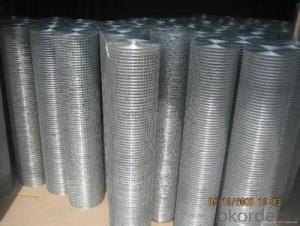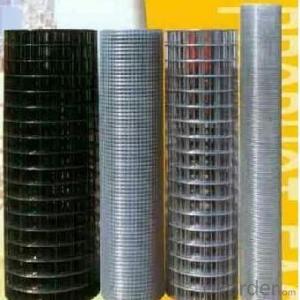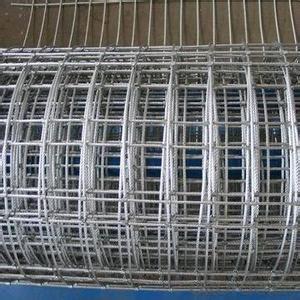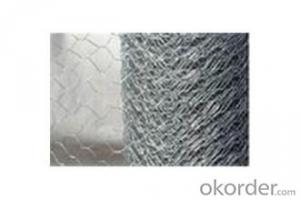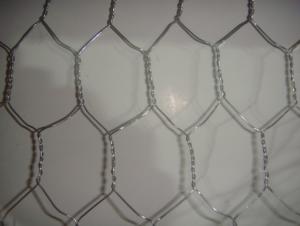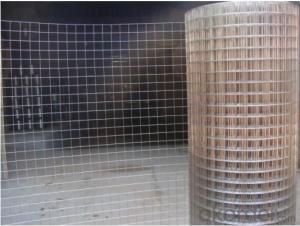Galvanized Hexagonal Wire Netting-1-1/4 inch
- Loading Port:
- China Main Port
- Payment Terms:
- TT or LC
- Min Order Qty:
- 50 roll
- Supply Capability:
- 5000 roll/month
OKorder Service Pledge
OKorder Financial Service
You Might Also Like
Introduction of Galvanized Hexagonal Wire Mesh
Galvanized Hexagonal Wire Mesh is made of by high quality galvanized wire, Low carton steel wire, stainless steel wire, iron wire, Galvanized steel wire.
Application of Galvanized Hexagonal Wire Mesh
Galvanized Hexagonal Wire Mesh is widely used in industrial and agricultural constructions, Rockwool, fence for poultry cage, fishing cage, playground fence and Christmas decorations
Surface treatment of Galvanized Hexagonal Wire Mesh
a. Black (mild steel wire)
b. Electro galvanized, (galvanized before welding, galvanized after welding)
c. Hot dip galvanized, (galvanized before welding, galvanized after welding)
d. Stainless Steel Wire
Advantage of Galvanized Hexagonal Wire Mesh
Our Galvanized Hexagonal Wire Mesh has strong corrosion-resisting and oxidation-resisting, stable shape, clean ends, good packing with good quality and rock bottom price.
Packing of Galvanized Hexagonal Wire Mesh
1. Waterproof paper then PVC shrinked
2. PVC shrinked only
3. Black waterproof paper only
4. Waterproof paper then metal/wooden pallet
5. Plastic film then carton
(Also as your request. )
Pictures of Galvanized Hexagonal Wire Mesh



Specification of Galvanized Hexagonal Wire Mesh
Galvanized Hexagonal Wire Mesh-Normal Twist | ||||||||||||||||||||||||||||||||||||||||||||||||||||||||||||||||||||||||
| ||||||||||||||||||||||||||||||||||||||||||||||||||||||||||||||||||||||||
Galvanized Hexagonal Wire Mesh-Revise Twist | ||||||||||||||||||||||||||||||||||||||||||||||||||||||||||||||||||||||||
| ||||||||||||||||||||||||||||||||||||||||||||||||||||||||||||||||||||||||
FAQ
We have organized several common questions for our clients,may help you sincerely:
1. How about your company?
A world class manufacturer & supplier of welded wire mesh and is one of the large-scale professional investment Galvanized Hexagonal Wire Mesh bases in China. Annually more than 1000 containers of welded wire mesh are exported to markets in Europe, America and Japan.
2. What is the storage condition?
The Galvanized Hexagonal Wire Mesh should be stored at room temperature and kept from wet and heat source.
3. How to guarantee the quality of the products?
We have established the international advanced quality management system,every link from raw material to final product we have strict quality test;We resolutely put an end to unqualified products flowing into the market. At the same time, we will provide necessary follow-up service assurance.
4. How long can we receive the product after purchase?
In the purchase of product within four working days, we will arrange the factory delivery as soon as possible. The specific time of receiving is related to the state and position of customers. Commonly 7 to 10 working days can be served.
- Q: What are the benefits of using steel wire mesh in the textile recycling industry?
- Using steel wire mesh in the textile recycling industry offers numerous advantages. Firstly, it enhances the durability and strength of the recycling process. Effectively handling and processing different fabrics requires sorting and separating, which steel wire mesh facilitates. It withstands the wear and tear of recycling, ensuring the mesh's longevity. Secondly, steel wire mesh enables efficient sorting and separation of textiles. Its sturdy and flexible nature makes it suitable for various stages of recycling, including sieving, sorting, and filtering. This streamlines and improves the accuracy of the recycling process by separating fabrics based on size, density, or composition. Furthermore, steel wire mesh is highly resistant to corrosion and can endure harsh chemicals and cleaning agents. In the textile recycling industry, where chemicals and detergents are used to eliminate stains and contaminants from fabrics, steel wire mesh remains efficient and long-lasting. Moreover, maintaining and cleaning steel wire mesh is easy. It can be washed or brushed to remove accumulated debris or fibers, ensuring its functionality for extended periods. This simplicity in maintenance reduces downtime and increases productivity during recycling. Lastly, steel wire mesh is an environmentally friendly choice for the textile recycling industry. Being recyclable itself, it aligns with the industry's sustainability goals. By using steel wire mesh, the need for disposable filters or screens is minimized, reducing waste and lessening the environmental impact of recycling. In conclusion, the advantages of using steel wire mesh in textile recycling encompass durability, efficient sorting and separation, resistance to corrosion and chemicals, ease of maintenance, and sustainability. Its versatility and reliability make it an excellent option for various stages of textile recycling, contributing to a more efficient and eco-friendly industry.
- Q: What are the main applications of steel wire mesh?
- Due to its durability, strength, and versatility, steel wire mesh finds a wide range of applications. The primary uses of steel wire mesh include: 1. Construction: In the construction industry, steel wire mesh is extensively employed to reinforce concrete structures like walls, columns, and foundations. It imparts strength and stability to the concrete, enhancing its resistance to cracks and structural failures. 2. Fencing and security: Steel wire mesh is widely utilized for fencing purposes, be it for residential, commercial, or industrial settings. It forms a robust barrier that is challenging to breach, thereby enhancing security and privacy. Moreover, steel wire mesh is frequently employed in high-security areas such as prisons or military installations to prevent unauthorized access. 3. Filtration and separation: Various filtration systems utilize steel wire mesh to separate or filter different substances. It is commonly employed in industrial applications such as oil and gas, mining, and wastewater treatment. The mesh size and shape can be customized to meet specific filtration requirements, ensuring efficient separation of solids and liquids. 4. Animal enclosures and cages: In zoos, veterinary clinics, and farms, steel wire mesh is often employed to create animal enclosures and cages. It provides a secure and durable barrier while allowing proper ventilation and visibility. Additionally, steel wire mesh can be galvanized or coated to resist corrosion and withstand harsh weather conditions. 5. Landscaping and gardening: Steel wire mesh is commonly used in landscaping and gardening applications. It can be utilized to create trellises for climbing plants, support structures for vegetable gardens, or to protect plants from pests. The durability and strength of steel wire mesh make it suitable for outdoor use, even in areas with harsh weather conditions. 6. Industrial storage and shelving: Steel wire mesh is frequently employed in industrial storage systems like pallet racking and shelving units. It provides a strong and stable platform for storing heavy items, thereby increasing storage capacity and organization. The open design of the mesh allows for airflow, reducing the risk of moisture buildup and corrosion. In conclusion, steel wire mesh is an adaptable material with a multitude of applications. Its strength, durability, and customization options make it ideal for construction, fencing, filtration, animal enclosures, landscaping, and industrial storage.
- Q: Can steel wire mesh be powder coated?
- Yes, steel wire mesh can be powder coated. Powder coating is a method of applying a dry powder paint onto a surface. The steel wire mesh is first cleaned and pre-treated to ensure proper adhesion of the powder coating. Then, the mesh is electrostatically charged and the powder is applied evenly to the surface. The coated mesh is then heated, causing the powder to melt and form a durable, protective finish. Powder coating is a popular choice for steel wire mesh as it provides excellent corrosion resistance, durability, and a wide range of color options.
- Q: Can steel wire mesh be used for creating safety barriers?
- Yes, steel wire mesh can be used for creating safety barriers. Steel wire mesh is known for its strength and durability, making it an excellent choice for applications where safety is a priority. It can be used to create barriers in various settings such as construction sites, industrial facilities, sports venues, and highways. Steel wire mesh barriers are effective in preventing unauthorized access, protecting pedestrians from falling objects, and controlling the movement of vehicles. It provides a secure and sturdy barrier that can withstand harsh weather conditions and potential impacts. Additionally, steel wire mesh barriers are cost-effective, low-maintenance, and can be easily installed and customized to fit specific requirements. Overall, steel wire mesh is a reliable and versatile material for creating safety barriers.
- Q: Can steel wire mesh be used for architectural elements such as facades?
- Yes, steel wire mesh can be used for architectural elements such as facades. It offers durability, flexibility, and a modern aesthetic, making it suitable for creating unique and visually appealing designs. Additionally, steel wire mesh can provide ventilation, sun shading, and privacy while allowing natural light to pass through.
- Q: Is steel wire mesh suitable for ballast or retaining walls?
- By itself, steel wire mesh is generally unsuitable for ballast or retaining walls. These types of walls necessitate materials that possess adequate strength, durability, and stability to withstand the exerted forces. Although steel wire mesh can be utilized as a reinforcing element in conjunction with other materials, such as concrete, it is not commonly employed as the primary material for ballast or retaining walls. Regarding ballast walls, which serve to support tracks or roadbeds, crushed stone or gravel are commonly employed materials. These substances offer stability, drainage, and ensure the proper distribution of load and forces. On the other hand, retaining walls are designed to hold back soil or other materials and require materials with high structural integrity. Steel wire mesh alone may not possess the necessary strength and stability to support the lateral pressure imposed by the retained material. However, steel wire mesh can be employed as a reinforcement within a retaining wall structure, typically in combination with concrete or other materials, to enhance its strength and stability. In conclusion, while steel wire mesh can contribute to the construction of ballast or retaining walls as a reinforcing material, it is generally unsuitable as the primary material for these structures due to its limited strength and stability.
- Q: Can steel wire mesh be used for ceiling panels?
- Certainly, ceiling panels can indeed be constructed using steel wire mesh. This versatile material boasts a multitude of advantages when used for ceiling purposes. Not only does it lend a contemporary and industrial vibe to the ceiling, but it also facilitates proper air ventilation and circulation. With its robust and enduring nature, steel wire mesh proves to be ideal for areas with heavy foot traffic. Moreover, it effortlessly adapts to various ceiling sizes and shapes, allowing for easy customization. Additionally, steel wire mesh can be painted or coated to match any desired color or aesthetic, thereby enhancing the overall design of the space. In summary, steel wire mesh presents itself as a pragmatic and visually pleasing choice for ceiling panels.
- Q: How does steel wire mesh perform in terms of airflow?
- Steel wire mesh performs well in terms of airflow due to its open design. The interwoven pattern of the wires allows air to pass through the mesh easily, facilitating good ventilation. This makes it an ideal material for applications where airflow is crucial, such as air filtration systems, ventilation panels, and screens for windows or doors. The open structure of steel wire mesh ensures that there is minimal resistance to the passage of air, providing efficient airflow while still maintaining its structural integrity.
- Q: What are the typical applications of steel wire mesh?
- Steel wire mesh is commonly used in a variety of applications including fencing, construction, reinforcement, filtration, and separation. It is often used for creating security barriers, enclosures, and partitions, as well as providing support and stability in concrete structures. Additionally, steel wire mesh is utilized in industrial settings for straining and filtering liquids and solids, and in agriculture for animal cages and crop protection.
- Q: Is steel wire mesh suitable for playgrounds?
- Yes, steel wire mesh is suitable for playgrounds. It is a durable and strong material that can be used for various applications in playgrounds, such as fencing, climbing structures, and safety nets. It provides excellent protection, security, and visibility while ensuring the safety of children during play.
Send your message to us
Galvanized Hexagonal Wire Netting-1-1/4 inch
- Loading Port:
- China Main Port
- Payment Terms:
- TT or LC
- Min Order Qty:
- 50 roll
- Supply Capability:
- 5000 roll/month
OKorder Service Pledge
OKorder Financial Service
Similar products
Hot products
Hot Searches
Related keywords





